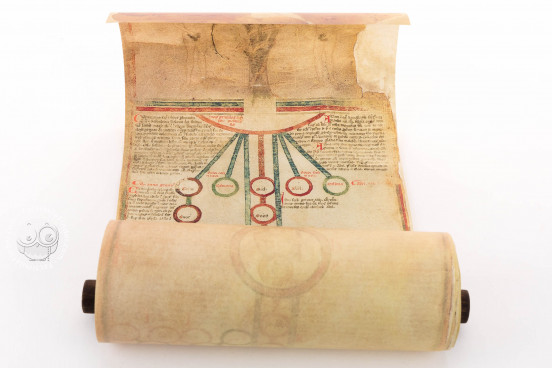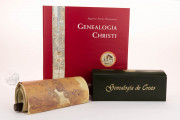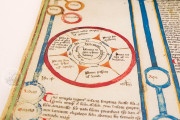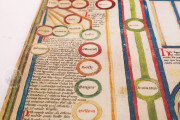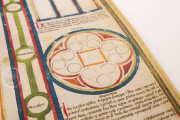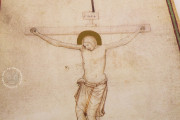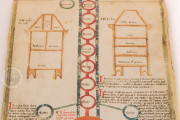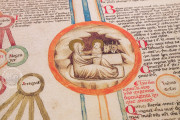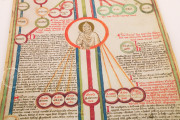The Genealogy of Christ presents the Historical Compendium of the Genealogy of Christ attributed to Peter of Poitiers in a continuous roll that encapsulates Old Testament history into a series of brief biographies and diagrammatic lineages. The Casanatense manuscript was created in Tuscany around 1320-1340. It is distinguished from earlier copies for its figural illumination, which is both extraordinarily sophisticated in conception and delicate in its execution. The roll begins and ends with representations of the Fall of Humanity and the Crucifixion extending across the roll's width; six more images are contained in small roundels.
Although the idea that the roll form of the Genealogy was beneficial for classroom display is attractive, in practice, the surviving rolls are all too long to have been used in this way. Even the relatively small Casanatense roll extends to more than 3 meters, too long to be visible at once.
Ages of the World
The Genealogy presents Christian history divided into six ages, each identified as beginning with a biblical personage: Adam, Noah, Abraham, David, Zekeriah, and Jesus Christ. The first and last of these are represented in narrative settings: Adam with Eve as she reaches for the fruit of the Tree of Knowledge and Christ in three scenes: the Nativity and Jesus among the Doctors in the Temple (in roundels) and the Crucifixion.
The Old Testament figures that mark the beginnings of new ages are pictured with distinguishing attributes: Noah with a saw, Abraham with a knife, and David and Zekeriah with scepters. The inclusion of these objects distinguishes them from Isaac and Jacob, the patriarchs who merit portraits but do not signal new epochs. The artist thus has expanded on the text while preserving its message.
The Tree of Life
The roll's two large miniatures frame the genealogy and stress the continuity of the presented history: the Tree of Knowledge at the center of the Fall of Humanity scene is echoed in the wood of the cross of the Crucifixion, which draws on the Christian understanding of the relationship of the trees of Paradise with the wood of the cross. Both scenes are reduced to essential figures, with Adam and Eve at either side of the Tree of Knowledge mirrored in the figures of the Virgin Mary and Saint Francis at the foot of the cross.
Color Symbolism
The text is written in Gothic Textualis, the formal script of the period. The color scheme of the Genealogy helps to articulate its message. The patriarchs, kings, and the holy figures of the Christological scenes—all rendered in finely shaded tones of brown ink—have gold halos. And, in principle, the colors of the frames of the roundels articulate the status of the people named: green for women, red and ocher for men, and blue for prophets.
An Extraordinary Teaching Tool
The intention of the Historical Compendium was to create a study aid for learning Old Testament and salvation history. It was quickly recognized as an effective teaching tool and was often copied, at first principally in France and England, in the thirteenth and fourteenth centuries. The copy now in Rome was purchased in 1770 from Nicola Ugolini de Foligno for the Biblioteca Casanatense.
We have 1 facsimile edition of the manuscript "Genealogy of Christ": Genealogía de Cristo facsimile edition, published by M. Moleiro Editor, 1999
Request Info / Price
